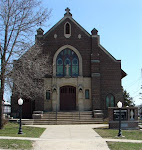Friday, September 24, 2010
Hermeneutic of Rupture
Father Pisut,
I recently read your response to the question posed to you about the ordination of women to the priesthood. Thank you for that clarification. It seems to me that the very need to respond to such a question — or any number of other questions that people mistakenly believe are yet unanswered by the Church — stems from a concept I've heard about in recent years called the Hermeneutic of Rupture. Its competing concept is called the Hermeneutic of Continuity. These are big, confusing terms. Just what do they mean; how do they relate to the aftermath of Vatican II; and why do many Catholics – and even non Catholics – believe that so many things are up in the air in the Church?
Rob
Rob,
Our Holy Father Pope Benedict XVI has used the expressions of the Hermeneutic of Rupture and Hermeneutic of Continuity to describe differing understandings of the Second Vatican Council. For most of the time following Vatican II the Hermeneutic of Rupture has held sway. In its most radical sense this vision claims that Vatican II was a new beginning for the Church. This was an outgrowth of the secularizing trends of the day that many perceived as a new Enlightenment. Just as society was undergoing radical change this same attitude of radical change found its way into the Church. This vision combined both the radical acceptance of the new morality of the day that jettisoned the traditional morality of both the Church and society. In addition there was also the impression that some of the changes in the Church, such as with the Mass, were a return to a more accurate reality of the Church in its primitive stage. In reality the response of many to the Second Vatican Council was more like a second Protestant Reformation in the Church. Just as many Protestant reformers felt that the Church was corrupt and they had to toss everything out and start new so did many Catholics in the Church. In addition, the hoped for return to the early purer Church, which of course is never possible, was also based in a hopeful vision of the past more rooted in 1960's idealism which more in depth study has shown to be inaccurate. In the end, while many proponents of the Rupture theory claim to speak in the "Spirit of Vatican II" in reality much of what they justify according to that "Spirit" is in direct opposition to what the council fathers taught as written in the documents.
The Hermeneutic of Continuity that Pope Benedict XVI speaks of asserts (and rightly so) that the Second Vatican Council must not be read in opposition to the history, Tradition and teaching authority of the Church but rather in continuity with it. The truth does not change, there may be development in or understanding that moves us forward but there can be no rupture. The objective moral order cannot change just because society says so. In terms of the Sacred Liturgy even though some changes were made they are not as extensive as many claim. When celebrating the new order of the Mass we should be informed by the Tradition as opposed to trying out novel ideas and creating our own Liturgy. In recent years some have responded to the reassertion of the moral teaching of the Church and a return to a more traditional way of celebrating the Holy Sacrifice of the Mass as "going backwards" or "turning the clock back." This is a misunderstanding caused by the Hermeneutic of Rupture. In reality the moral teaching of the Church and the tradition of the Liturgy have always been taught and supported but persons were taught otherwise or never encountered them. With the stronger presence of these elements where before they were lacking it is understandable how some may perceive it as going backward but this is actually a result of the sad misunderstandings and abuses of the past forty years. For instance the Second Vatican Council never prohibited Mass in Latin or required the vernacular but rather allowed the vernacular and kept Latin as the norm. One can debate the merits and shortcomings of either but that is a separate issue of what the council taught.
Ultimately, the Church gave us the Second Vatican Council and the Church alone has the right to interpret what that means. The Second Vatican Council taught that the Church should engage the modern world in order to bring it to Christ. Sadly, the Hermeneutic of Rupture led the Church to embrace the world and jettison its faith. By returning to a Hermeneutic of Continuity we retain the deposit of faith given to us by Christ and entrusted to the Church as well as benefitting from the wisdom and Tradition of the Church that brings us ever closer to Christ.
Fr. Pisut




